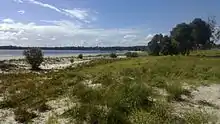Gnangara Mound
The Gnangara Mound is an area north of Perth, Western Australia where a large mound of sandy soil reaches an elevation of about 60 metres (200 ft). It stores about 20 cubic kilometres (710 billion cubic feet) of fresh water, about one hundred times Perth's current annual water usage. It is currently the single most important source of potable water for the city. Together with the Jandakot Mound in the south of Perth it supplies about 35%–50% of the city's drinking water.[1]

However, studies have shown that water levels in the Gnangara Mound have fallen substantially in recent times. This has had a significant impact on nearby groundwater-dependent ecosystems such as the Wanneroo wetlands and the Yanchep caves. The problem has also been causing acidification of the nearby Lakes Gnangara, Jandabup, Wilgarup and Mariginiup. The remaining mound springs of the Swan Coastal Plain depend on the aquifer and are susceptible to any dramatic change in hydrology. It is widely recognised that sustainability of the Mound as a water resource is under threat. Depletion has been blamed on a combination of climate change and excessive drawing of water.[2]
References
- "Gnangara Mound Saga". Archived from the original on 28 January 2013. Retrieved 13 February 2007.
- "The Water Supply in Perth, Australia". Retrieved 13 February 2007.
- Burbidge, Andrew A (2004). "10. Threatened ecological communities". Threatened animals of Western Australia. Department of Conservation and Land Management. p. 169. ISBN 0-7307-5549-5.
Threats: ... remaining occurrences are threatened by hydrological change, cattle grazing weed invasion and altered fire regimes.
- Specific
- "Integrated Water Supply System". Water Corporation. 29 October 2010. Archived from the original on 30 November 2010.
- Emerson, Christine; University of Western Australia. School of Agricultural and Resource Economics (2005), Gnangara Mound : groundwater v pine plantations--the exploration of an ecological-economic systems approach towards solving a resource allocation problem, retrieved 14 April 2018